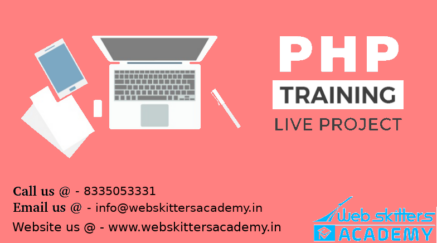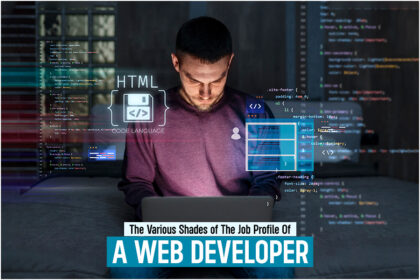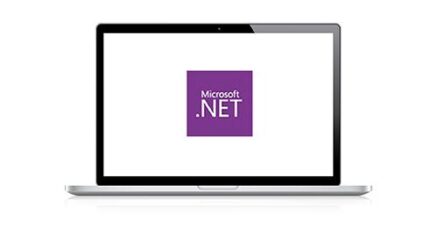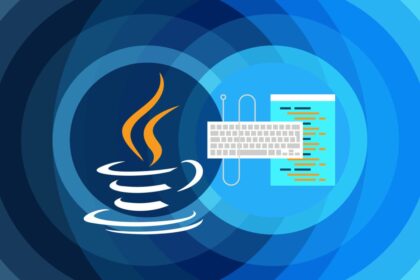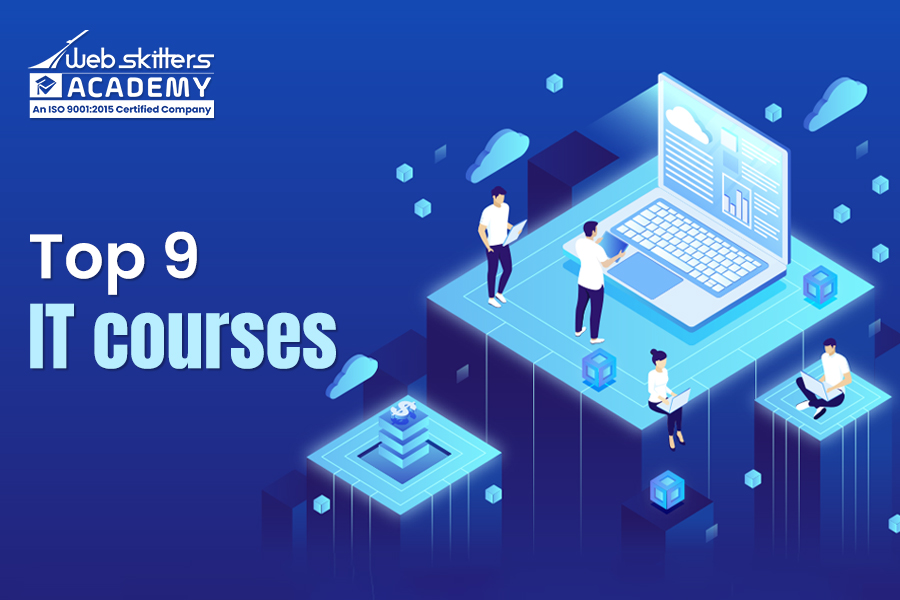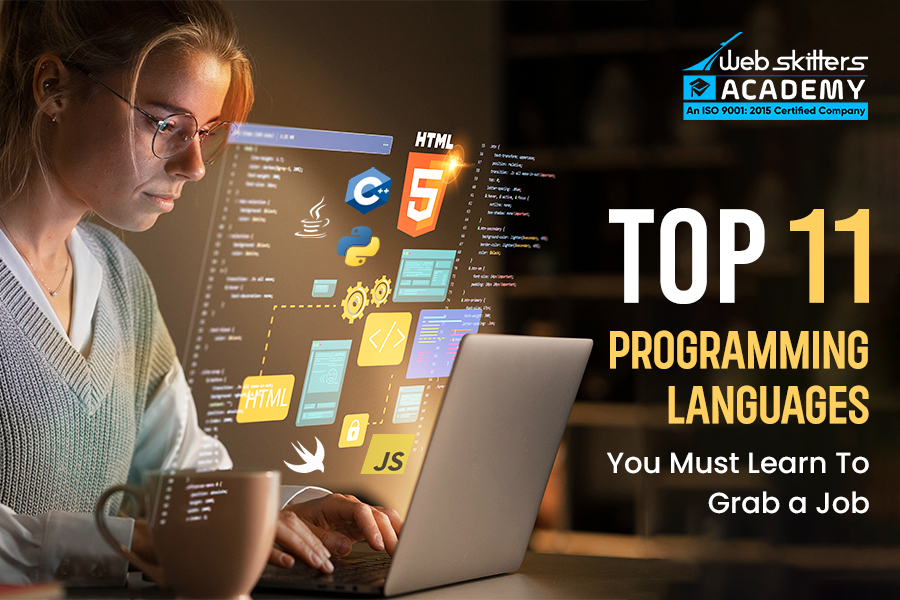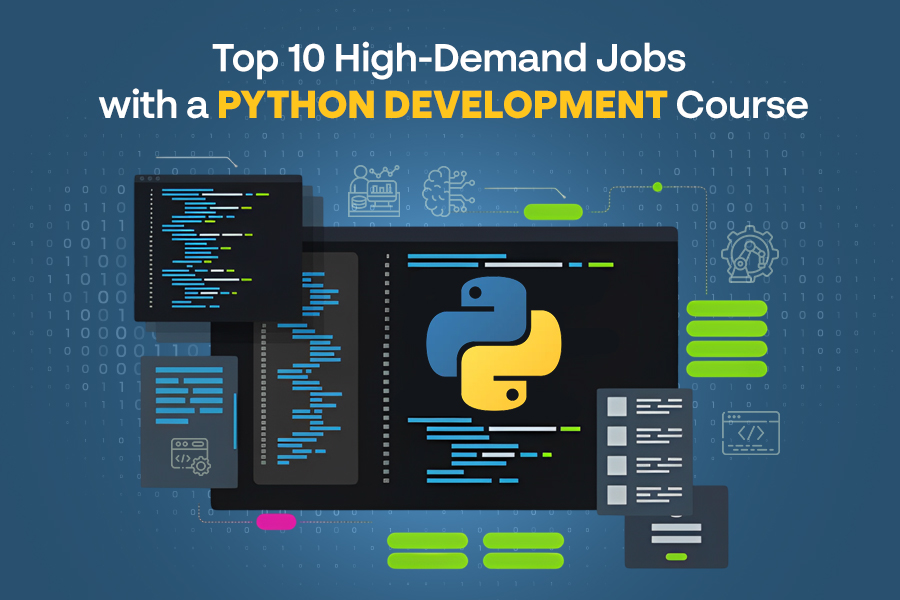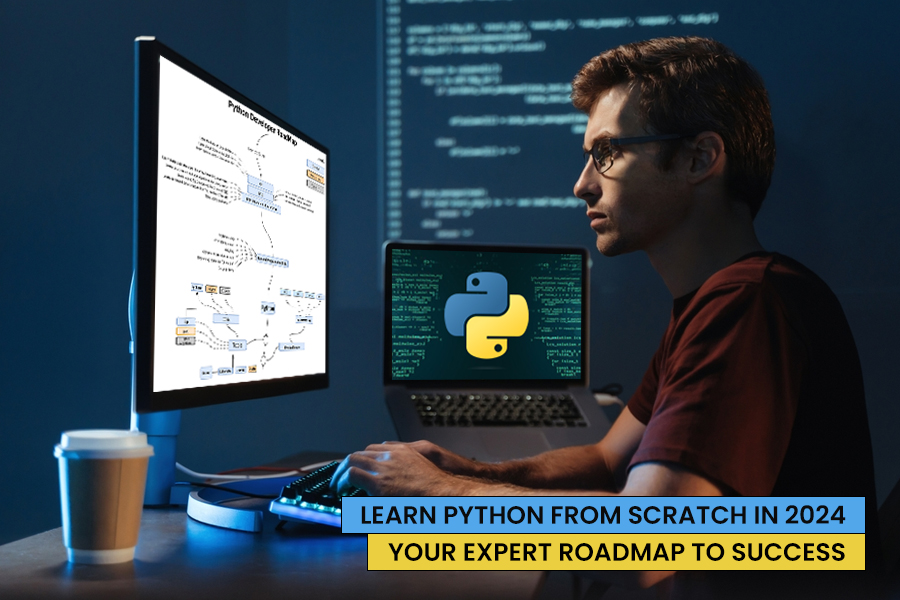
Python is the most versatile and powerful tool in programming languages, with varied applications across multiple domains. In the modern era, Python programming has achieved a new height of success, with programmers worldwide praising its ease of use.
Python is an interpreted programming language created by Guido Van Rossum and further developed by the Python Software Foundation. The idea was to create a language in which programmers express their concepts within a few lines of code.
Miraculously, Python became the go-to language for the software industry. This general-purpose, superior-quality programming language is widely used among developers. Its enhanced readability, simplicity, and vitality make it the first choice of researchers and programmers.
Whether you want to begin as a novice or wish to develop your skills for various career prospects, you can learn Python from scratch.
Learning a Python course is an ideal way for beginners to start programming. Python has become a staple in various industries in this evolving digital landscape. Learning this language allows you to plan for a fantastic career ahead.
If you want to become a Python programmer, work with extensive data, develop websites, or acquire a new skill, this step-by-step guide will help you shape your career in the most resourceful way and eventually succeed.
We will comprehensively cover the need for a Python course, explaining its vast potential for the future and its impact across various industries and aspects of everyday life.
Why Learn Python in 2024?
Python is gaining popularity in this technology-driven market primarily because it uses precise words and easy-to-understand instructions.
Learning Python course in Kolkata will boost your career prospects, introduce you to the current market trends and enable you to solve real-world issues.
Python’s surge in popularity is not a passing trend; it is here to stay, especially in this age of generative AI. The language’s readability and simplicity are wooing programmers from across the globe.
A few compelling reasons to support our claim for Python’s undisputed supremacy can be summed in the following points:
The Dominant Phenomenon of Python
Python’s popularity is credited with its versatility in web applications, data science, and revolutionizing the artificial intelligence industry. Programmers often consider it a go-to language for developing diverse applications.
- Varied Industry Embrace
Python is welcomed by various industries wholeheartedly. Finance, e-commerce, banking, and every other sector use this language’s adaptability for seamless integration with their existing systems.
- Surge in AI and ML Demands
Recent years have seen a surge in Artificial Intelligence and Machine Learning applications. This has significantly contributed to the exceeding demand for Python developers. Python has inclusive features and characteristics that allow it to create complicated models effortlessly.
- Strong Job Prospects
The Python course ensures you achieve what you need—a great career prospect. With a high demand across various industries, Python developers need not look door-to-door for a job. It is easily and readily available, with exquisite opportunities varying according to professional proficiency.
- Competitive Salaries
As we mentioned above, the Python course has a wonderful prospect; the salary in this field is too lucrative. It might surprise you, but Python developers command a strong hold over a healthy package that is not easily available for other programming language developers.
- Simplicity and Readability of Python Code
Python is a simple programming language, evident by its readable syntax. Python code is written in simple English, making it more accessible and understandable for beginners.
Compared to other programming languages, Python requires fewer lines of code to perform the same operations and tasks.
- Community Support and Resources
Python is open source, and its supporters are huge. They participate in developing the language, which helps both learners and developers.
It even helps the community collect a huge amount of information, including detailed guides, instructions, meetups, forums, and other inputs. Thus, it makes it easy for people to get help and stay updated on innovations.
- Easy to integrate with other Programming Languages
Python has another unique feature: it can be integrated with other programming languages like Java or C++ for cross-platform development. Python is more powerful and has an extensive library, enabling you to enjoy its exclusive features.
Industries where Python is in demand
Python is a go-to programming language for beginners and experienced developers. Besides its popularity, learning Python course is essential as it has a wide range of applications in multiple industries, from finance, healthcare, tech, and more.
- Web Development and Backend Services
Python’s framework has transformed the overall scenario of web development. It enables developers to create secure, scalable, and various feature-filled web applications. Python’s simple syntax and wide range of libraries make it the best choice for building robust backend services, content management systems, and APIs.
Companies across the globe are increasingly turning towards the use of Python to develop scalable web applications.
- Data Science and Analytics
The excellence of the Python language in analysis, data manipulation, and visualization has led to its dominance in the field of data science. Certain libraries provide the necessary tools to manipulate and visualize complex datasets. Machine learning libraries like TensorFlow help data scientists develop predictive models and gain valuable insights from data.
These are a few highly sought-after skills in the current market. With Natural Language Processing, Artificial Intelligence, and Machine Learning conquering the world, Python-proficient skill developers have become extremely valuable.
- Artificial Intelligence and Machine Learning
Python is considered to be the natural language for developing artificial intelligence and other machine-learning applications. It enables researchers and developers to create advanced AI algorithms, neural networks, computer version systems, and natural language processing applications.
Python is well-suited for AI and ML program development, which is why efficient developers are in great demand.
- Scientific Computing
Python’s capability extends to scientific computing, and it plays a vital role in modeling, simulations, and scientific research. It includes tools for mathematical optimization, numerical integration, signal processing, and more. Scientists from various fields use Python to analyze data and solve intricate problems.
Python’s ability to inter-operate with various tools makes it a preferred language for scientific computing. Its simplicity and dynamic nature also influenced its role in the industry.
- Internet of Things (IoT)
The lightweight feature makes Python suitable for developing applications in the IoT space. The clarity and wide range of libraries facilitate the creation of applications for controlling and managing connected devices.
With Python, developers can collect, process, and analyze data from multiple IoT sensors.
- Finance and Algorithmic Trading
It has also become a popular choice in the financial sector. Many traders and analysts use Python to build trading systems with algorithms, carry out quantitative analysis, and develop financial models. Thus, it helps professionals work effectively with financial data.
Risk management systems, financial analytical tools and algorithm development require processing a wide range of data, which is done smoothly through the Python platform.
- Healthcare and Medical Research
Python is also used in the healthcare industry, helping with medical research, data analysis, and patient management. Researchers use It to analyze huge medical datasets, simulate biological processes, and more.
The healthcare industry is leveraging Python to streamline its operations. The demand for Python in this industry is reaching new heights, with further development requirements coming to the surface.
Career opportunities and salary prospects for Python developers
Python’s role in recent years has travelled beyond programming. It has shaped itself as a crucial tool for understanding and carving the future of AI. Although many new programming languages are entering the field, Python’s dominance is here to stay. It is likely to grow in the future.
Embracing Python skills brings countless career opportunities and lucrative salary prospects to brighten your future. To name a few, here are the career prospects that you can pursue as a Python developer:
- Data Scientist
One of the most promising ways for career growth now is data science, and Python is the top language for data scientists. Data scientists are considered to be the detectives of the data world. Diving into the deep sea of data and information, they play a key role in predicting and identifying customer segments and other vital information.
- Python Developer
Django and Flask are Python’s frameworks, majorly used in the development of web applications. These help developers create secure and easy-to-maintain web applications, just as required. Thus, becoming a web developer with Python programming is a great career prospect. One needs to be involved in data analysis, machine learning, and Python libraries to prosper in this career.
- Machine Learning Engineer
Machine learning engineers use this language to create multiple algorithms and models to let the machine learn and choose accordingly. Programs like Keras and TensorFlow make Python evident in this field. This career option comes with an understanding of both computer programming and mathematics. These professionals are in demand for their skills in creating mind-blowing programs and analytics.
- Software Developer
Python applies to multiple software development projects, such as desktop applications, Internet applications, or enterprise solutions. Its flexibility helps to create all-rounder developers who can work in various fields and platforms and thus are a vital resource to the tech teams.
- Automation Engineer
The automation engineers work with the Automator’s script with Python codes designed to carry out repetitive tasks to enhance efficacy. With Selenium and PyAutoGUI, desktop and web applications can be automated, making Python vital.
Salary Expectations
In India, Python developers earn according to their performance and productivity. The average salary starts at INR 4-6 Lakhs per annum and skilled professionals can earn around INR 15-20 lakhs per annum. Some specific positions, such as data scientist or machine learning engineer, can receive even higher salaries. Thus, in today’s digital era, it is crucial to learn Python from scratch.
Setting Up Your Python Environment
The first step to learning Python development and building a solid career understands its environment and setup. With professional support and guidance, you can learn the step-by-step process of installing Python on Windows, Mac, and Linux.
We have discussed the best installation methods for each platform here to give you sound knowledge. Let’s dive in to learn more.
Install Python on Windows –
There are three ways you can install Python on Windows, they are –
Using the Microsoft Store
Microsoft has a community release of Python 3 in the Microsoft Store. It is the ideal way to install Python on Windows, as it handles the updates automatically and can be easily uninstalled.
- To use this process, you have to open the Microsoft Store and search for Python
- Then you have to pick the newest version and install it
With the official installer
You can also download the Python installer from the official website. This method does not provide automatic updates, so it is not the best. While using this installer, ensure that you mark the checkbox saying “Add Python to PATH.”
Inside WSL
If you are familiar with the Windows subsystem for Linux, you can install this option, too. It offers the benefits of Windows while using Linux, as it provides good hardware support.
Installation on macOS
In most versions of MacOS, Python distribution is already included. However, it comes in an older version, Python 2.7.
To install Python 3 on a Mac there are two ways –
Homebrew
First and foremost, I recommend looking into Homebrew. It allows you to install almost anything quickly. The added benefits:
Homebrew allows you to install almost every software required for Mac. The packages remain updated accordingly, and it is easy to upgrade to newer versions whenever needed.
However, you must be comfortable using a command-line shell to use Homebrew. If that’s entirely new for you, I recommend the following option for now: using the official installer.
Open the terminal application. You can find it in Applications > Utilities > Terminal.
Then you have to type the following command and press Enter
Code language: Bash (bash)
python3–version
Official installer
You can also download an installer from the Python download website. It’s easy and functions like installing any other MacOS software. Like Windows, ensure that Python is added to your system’s PATH.
Install Python on Linux
There are various ways to install Python on Linux. First, you need to check if it is already installed. Most Linux distributions include Python, and some even include both Python 2 and Python 3.
You will see the version number if you enter the Python version on the command line. Like
Code language: Bash (bash)
2.7: $ Python –version will appear like Python 2.7.16.
If you try the same for the Python 3 version and get “command not found”, then you have to install Python 3.
But if it’s pre-installed, it will appear
Code language: Bash (bash)
$ python3 –version as Python 3.8.5.
Using a package manager
Depending on the Linux distribution, you can install Python with the default package manager, such as Yum, APT, etc. You must determine which package manager to use for your specific Linux distribution and how to use it.
Another option for Linux to install Python is Homebrew. The package manager for Mac also works on Linux.
Choose your IDE
An IDE, or Integrated Development Environment, is a software application that provides multiple facilities for software development. It incorporates different tools and features, such as debugging tools, a source code editor, project management tools, and more, into a single application, helping to streamline the development process.
Let’s learn about the popular Integrated Development Environments (IDEs)
- PyCharm
PyCharm is cross-platform, as it is compatible with Windows, Linux, and macOS; being part of the Python IDE is essential for professional development. It is famous for its intelligent code completion, testing, and debugging features. It supports libraries and frameworks, thus making it an ideal choice for data science and web development. It also has a community edition, which is free and open source.
- Jupyter Notebook
Jupyter Notebook is an open-source web application that allows you to create and share documents containing codes, texts, and visualizations. It has a user-friendly interface and supports features like interactive widgets, real-time data visualizations, and collaborations. It can also integrate with various programming languages, such as Python, PHP, R, etc.
- Visual Studio Code
Visual Studio Code, or VS Code, is a lightweight and versatile IDE well-known among professional Python developers. It offers a varied set of features, including code completion, debugging, and source control integration. It also has a wide collection of extensions and plugins, which enhance the overall coding experience.
New Learners- Get informed about Python Basics
Python is one of the most vital programming languages nowadays. Professional developers focus on implementing programs rather than writing complex ones, making Python the ideal solution due to its ease of readability and access.
- Python Syntax and Basics
The syntax is how Python is written, mainly in the order and manner in which a line of code is constructed. It helps to determine how the various statements written in Python will be interpreted.
One of Python’s most essential factors is its syntax; it needs to be simple, readable, and concise. Even some of the other features, like decorators, iterators, or generators, if implemented in the right way, can make the code easy to understand and change.
- Variables
A variable is a reserved memory location that is used to store data. It stores data, which can be changed during the program if required. In Python, naming a variable follows the same rule as identifiers.
The variable type in Python needs no specification as the language derives it independently. A variable gets created as soon as a value is assigned to it. One doesn’t need any additional commands to declare a variable in Python.
- Data type
In statically typed languages like C or Java, defining the variable’s data type is not required. In dynamically typed languages like Python, the interpreter predicts the data type of the variable based on the type of value assigned to that variable.
A data type is defined as the classification of the types of values that can be assigned to variables. In Python, it is important to understand the different types of values that can be assigned to variables.
Python data types are categorized into two sections:
- Mutable Data Types: In Python, data types where the value is assigned to the variable can be modified. Mutable data types include set, list, dictionary, and user-defined classes.
- Immutable Data Types: In Python, immutable data types are those in which the value assigned to a variable can’t be changed. Examples of immutable data types in Python are int, decimal, float, tuple, bool, range, and string.
Write your first Python program
You need to learn the Python basics to start writing a Python program, like a basic “Hello, World!” script.
A simple script is a simple and complete first program for beginners, ideal for testing systems and programming environments.
For example, “Hello, World!” defines the basic syntax of the programming languages. This process helps you understand the syntax and structure of Python code.
The basics of this process are –
- Python data structures
Python offers multiple built-in data structures, such as lists, tuples, sets, and dictionaries. These data structures store and control the data in programs. The Python course includes a section dedicated to data structures and algorithms in Python that covers a wide range of these aspects.
- Control flow in Python
Control flow statements, like for-loops, if-statements, and while-loops, allow the program to make decisions and repeat actions. Implementing these statements helps develop a Python program.
- Functions in Python
The functions in Python are blocks of reusable code that carry out a specific task. You can define your functions and write a Python program with built-in Python functions. With a beginner’s guide to Python, you can write reusable, complex and consistent tasks as required for the program.
What are Control Structures?
Control structures are crucial to programming. They enable you to specify the flow of execution in your code. In Python, there are various types of control structures, including conditions, loops, and calling functions. These are essential for making decisions and repeating tasks.
- Conditional statements
Conditional statements help to change a program’s behaviour depending on whether some conditions are true or not. They are used in almost all programming languages and take the form of if or switch conditions.
- “If”-statement
In Python, an if statement consists of the “if” word, followed by a condition and then a colon. The colon is required as it separates the header of the statement from the body. Indentations are essential in Python.
An improper indentation might result in errors that are difficult to solve. The condition after “if” has two possibilities. If it is true, then all the following statements will be executed. If the condition is false, the program will skip the lines of code associated with the if-statement and move on to whatever comes later.
- “Else”-statement
Suppose you want one thing to happen when a condition turns out to be accurate and something different when it is false; this situation can be addressed using an if-else statement. This statement is checked to see if it’s true or not. If it is true, the code block under the “if” statement is run. If the statement is false, all the statements under the “else” statement are run in that place.
- Loops
Loops are a way of Python coding that allows you to continue a specific task for a given number of iterations while something else is happening. The commands required to build loops are for and while. These loops are vital components of any program; they are used to repeat blocks of code for a certain number of times.
- Functions
Functions are blocks of reusable code that help to perform a specific task. In Python, a function is declared by “def” before the name of the function. Python doesn’t need to specify the function’s return type. The function can be used by writing the name and the parameter list in the brackets.
- Modules
In Python, modules allow programmers to write modular, reusable, and even organized code. Creating a module helps define functions or variables once and then reuse them throughout the code by importing the module. This saves time, improves readability, and reduces errors.
Start Building Your Python Skills
As you embrace the idea of making a great career in this enthusiastic and high-demand Python industry, you must build your skills. With the proper guidance and training through the Python course, you can be proficient in the section and enhance your knowledge about variables, data structures, control structures, and file handling.
Until you enrol in the best Python course, let us give you a brief overview of the foundation that will help you build your skills in the sector.
- Data Structures
Python includes various built-in data structures, such as lists, tuples, sets, and dictionaries. These structures are considered containers that help sort and group data according to type.
- Lists
Lists are simple containers that are considered an integral part of the Python language. A single list might contain data types like Strings, Integers, and Objects. Python lists are known as the dynamically sized arrays that are declared in other languages (vector in C++ and ArrayList in Java). They are enclosed in [] and separated by commas.
- Dictionaries
Python dictionaries are similar to the real-world dictionaries. These mutable data structures contain a collection of keys and are associated with values. This structure makes them quite similar to the word-definition dictionaries.
- Sets
In Python, sets are mutable dynamic collections of immutable elements. The elements contained in a set must be unique, as duplicates are not allowed. Thus, sets can be easily used to remove duplicates from a list.
- Tuples
Tuples are identical to lists, contain a sorted and ordered collection of elements, and are immutable. They can be used when a data structure cannot be modified anymore. If all the elements are immutable, they can also be used as dictionary keys.
File Handling
File handling enables the storage of data that can be accessed by code for multiple purposes, such as writing, reading, modifying, and deleting data from files. It allows handling a file like an object so that various functions can be performed on the file.
Reading from and writing to files is a common task. You can write a message to a file and then read it back, thus demonstrating how Python handles file operations efficiently.
When a file is opened in reading mode, Python provides different methods like read(), readline(), and readlines() to fulfil various reading requirements. The read() method outputs the whole content at once, whereas readline() reads one line at a time. readlines() focuses on the entire file content as a list of lines.
Writing to a file in Python is just like reading. Open a file in write or append mode and use the write() or write lines () methods. The write() method engraves a string onto the file, and write lines () inscribes a list of strings as a separate line.
Exception Handling
For robust programs, graceful error handling is important. In Python, using try-except blocks, you can manage exceptions like dividing by zero without crashing the program. In the file handling part, errors are enormous obstructions.
Python’s try-except blocks work as the suspension system, absorbing shocks from FileNotFoundError, IOError, and other exceptions. Wrapping the file operations successfully in these blocks ensures proper handling of challenges.
Step-by-Step Python Learning
The Python language has become a basic part of the present digital ecosystem. It is essential to learn Python programming from scratch and acquire the skill. Python is used in various fields and is gaining popularity across all big tech companies like Google, Meta, Amazon, and Netflix.
The steps to learning Python go with your proficiency in the programming language. They vary from beginners to advanced levels.
- Beginners—Beginners should start with simple projects to apply basic concepts, such as a to-do list application, a number guessing game, creating a calculator, or data analysis using any dataset.
- Intermediate—At the intermediate level, you can build on the fundamental knowledge with more complex projects. These can include projects like a web scraper, a machine learning model using Scikit Learn, or creating a web application with Flask.
- Advanced—You can challenge your skills with advanced projects, such as performing data analysis with Panda, a full-stack web application, or a deep learning model using TensorFlow or PyTorch.
Best Python Courses and Resources for 2024
In 2024, Python is considered the most popular programming language, offering a promising career and a high salary. Whether you are a beginner or want to advance your skills, there are top Python courses and certifications that can pave the way towards success.
Learn Python in Kolkata
Many institutes and organizations are offering Python development courses. The curriculum covers fundamental concepts like object-oriented programming, data structures, algorithms, etc.
Through these Python tutorial courses, the students get hands-on experience with projects and assignments, thus ensuring a solid understanding of the Python concept, its basics and the advanced topics.
To start your Python learning journey, you must be informed about the latest courses and select the best institute.
These Python programming classes in Kolkata offer practical programming experience and help you establish yourself as a successful Python programmer.
Here is a reputable Python training institute in Kolkata:
Offering comprehensive information and learning opportunities, Webskitters Academy helps you learn from scratch and develop new opportunities for your future. It is one of the most renowned Python training institutes in Kolkata and Durgapur. Under the expert guidance of industry professionals as trainers, the institute offers efficient training to kickstart your learning.
Community and Meetups
You can engage with the local Python communities through different meetups and events.
- Kolkata Python Meetup – An ideal place to network, learn and share knowledge with other Python enthusiasts.
- Kolkata Geeks –A community of techies, including programmers and developers. They organize meetups, workshops, and events related to coding and technology.
- PyData Kolkata –This community focuses on data science and machine learning with Python.
Some of the virtual communities are –
- Python Software Foundation Community
- Python Projects Community
- Python Programming Community
Additional Learning Resources
The best thing about Python is that it is an easy language to learn and understand. Thus, books are excellent resources for new learners who want to learn and develop Python basics. Considering the reviews of various books, the following are the best Python programming books for readers new to programming and Python.
No previous programming experience is required to study these books. They start from the absolute basics, teaching general programming concepts and how they apply to Python.
Here are the best books to guide you through the Python journey –
- Python Crash Course: A Hands-On, Project-Based Introduction to Programming by Eric Matthes
- Automate the Boring Stuff With Python: Practical Programming for Total Beginners by Al Sweigart
- Fluent Python: Clear, Concise, and Effective Programming by Luciano Ramalho
- Introduction to Machine Learning With Python: A Guide for Data Scientists by Andreas C. Müller, Sarah Guido
- Python Cookbook by David Beazley, Brian K. Jones
Online Tutorials and Documentation
Online tutorials and documentation in Python help to improve code maintainability and make it easier to understand. It plays a crucial role in onboarding the new developers.
Essential online tutorials and official Python documentation are –
- Authentic Python –It offers tutorials and articles on various Python topics.
- Sphinx—Sphinx is one of the most popular Python documentation tools. It converts reStructuredText markup language into various output formats, such as HTML, LaTeX, plain text, and manual pages.
- pydoc—The pydoc module automatically generates documentation from Python modules. It can be presented as pages of text on the console suitable for a web browser or saved as HTML files.
- pdoc – a simple Python 3 command line tool and library to auto-generate API documentation for Python modules.
- pydoctor – It is made to fulfil the needs of Twisted projects.
- Doxygen – This can create documentation in various formats like (HTML, LaTeX, PDF). You can even include formulas in your documentation.
Embark On Your Python Learning Course with Webskitters Academy
Whether you’re a novice or have some experience in programming, consider starting a journey to Learn Python from Scratch.
You can choose from various resources such as video tutorials, written guides, books, podcasts, or blogs. You can also opt for a combination of methods, such as taking a video course and incorporating a Python podcast into your routine.
We at Webskitters Academy offer the best Python Job Oriented Course in Kolkata. We help you develop your skill level, manage your goals, and obtain certification within your budget. We provide you with best-in-class training using state-of-the-art infrastructure and high-end digital classroom facilities.
Industry experts are trainers at our institute, sharing their in-depth knowledge and first-hand experience. We guide you throughout the course and help you land a job under our placement guarantee program.
From setting up the ideal learning environment to helping you understand all the concepts and popular libraries, join us for the Best Python courses in 2024. Marvel your skills in the dynamic sphere of programming.
Search
I Want to Learn...
Category
Explore OurAll CoursesTransform Your Dreams
into Reality
Subscribe to Our Newsletter
"*" indicates required fields
 Course Fees Revising Soon! to Lock in the Current Price
Course Fees Revising Soon! to Lock in the Current Price 
